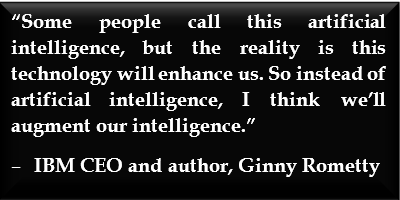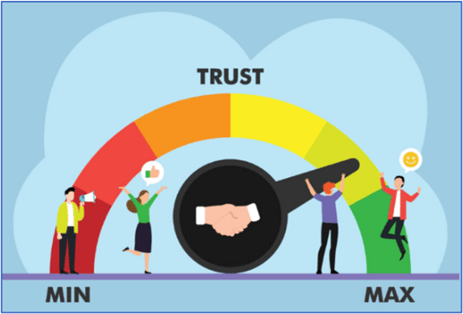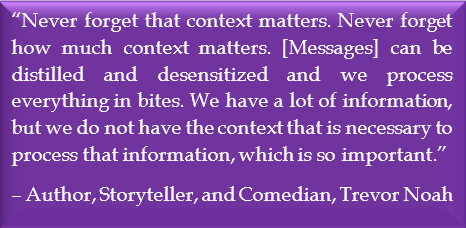As staff on the communications teams here at Hollaway, we are continuously looking ahead at the applicable innovations, trends, and best practices in communications necessary to be at the top of our game as public involvement and engagement experts. Effective communication not only builds a positive experience with our audiences and boosts client satisfaction, it also increases professional loyalty and trust. As we strive to be better communicators, our goal is to convey our client’s message efficiently and effectively. So how do we do this?
- ARTIFICIAL INTELLIGENCE: FOR BETTER OR WORSE OR BOTH?

Let’s begin with the most talked-about communication tool, artificial intelligence, or AI. Regarding AI’s capabilities and practicable functionality, the rhetorical questions we need to ask ourselves are: Can AI help us be more efficient and insightful in communication, especially regarding social listening and quantifying our target audience? And, does AI make things easier (i.e., in terms of drafting public surveys, developing questionnaires, or analyzing data)? Researchers have found that, ultimately, several things determine AI’s efficacy regarding its use as a tool of communication.
Good Data In and Combatting Misinformation
 One of these factors involves verifying factual data, which results in trusted messaging. In other words, the reputation of the source of information is everything. As communicators, it is our continual responsibility to verify not only the sources that we receive information from, but also the data itself. Transparent communicators of factual and detailed information are critically important in a time when global trust is low; according to the global Edelman Trust Barometer, 2024 is the year of “innovation in peril.” With exponential growth in technology, there has been growing distrust in AI, among other technological advances. With much of our messaging disseminated from government agencies for public infrastructure projects, we respect the gravity of the information we send to our audience. We understand how imperative it is that our communication process is transparent and accessible to elected officials, stakeholders, and the public.
One of these factors involves verifying factual data, which results in trusted messaging. In other words, the reputation of the source of information is everything. As communicators, it is our continual responsibility to verify not only the sources that we receive information from, but also the data itself. Transparent communicators of factual and detailed information are critically important in a time when global trust is low; according to the global Edelman Trust Barometer, 2024 is the year of “innovation in peril.” With exponential growth in technology, there has been growing distrust in AI, among other technological advances. With much of our messaging disseminated from government agencies for public infrastructure projects, we respect the gravity of the information we send to our audience. We understand how imperative it is that our communication process is transparent and accessible to elected officials, stakeholders, and the public.
Communication Efficiency
AI also has the potential to boost internal team communication efficiency. For example, many AIs specialize in natural language processing (NLP) and can quickly generate and proofread texts, as well as transcribe and summarize entire conversations. This can save time and eliminate workflow bottlenecks by:
- Generating transcripts of team meetings
- Creating meeting summaries and action items
- Generating first drafts of internal email copy
- Adding automatic proofreading to all internal communication
- STREAMLINING INTERNAL AND EXTERNAL COMMUNICATION
To streamline communication internally and externally means reworking the processes or methods you currently use to communicate to your team, associates, and clients, to be more efficient. It sounds simple enough, but how is it applicable in the day-to-day, in each of these capacities?
Internal Communication Processes
One method we have found that helps to streamline internal communication is to review current communication processes, ensuring communication channels are accessible and understood (e.g., holding internal and in-person monthly trainings, aka brunch and learns), and putting Standard Operating Procedures (SOPs) into place.
Though many businesses have invested in team collaboration tools since the advent of Covid-driven remote and hybrid work, the application of these tools is far from consistent. Employees still rely on email, as well as different messaging apps, to exchange information. If there is a lack of consistency and cohesiveness internally, team members who should be involved in email chains or group projects can get left out of the loop, and this can lead to higher turnover, unclear or missed deadlines, and a lack of general team knowledge.
Reviewing which of these channels is most efficient and then standardizing your SOPs across the board, while ensuring that your team adopts the changes implemented, can help to continue the communication efficiency conversation among the team.
Cloud Communication
For internal and external communication, cloud-based communication offers a more versatile, secure, and flexible alternative to locally based systems for anything from data storage to document sharing. This form of data sharing, if used correctly, can be instrumental in helping with version control, proofreading, group writing, and team editing. The most important thing to remember, however, is to ensure that you and your team, or client, are in agreement regarding which platform to use, are open and vocal about hiccups or glitches (that may pop up) with one platform versus another, are communicating these issues quickly, and are openly solving the problem — or are proactive in moving onto a platform that suits everyone’s purpose.
Mobile-First Communication
For external, audience-facing communication, statistics (statista.com) show that over 54% of internet traffic comes from mobile devices like smartphones and tablets. This means that all public communication should be usable on these devices. Ensuring that client and public-facing websites, especially with click-to-action/survey buttons, and live chat options and contact forms are easily accessible and displayed on phones and tablets is a must. Having mobile- and desktop-specific versions of your site (with an accessible QR code on your electronic and printed materials) that offer several custom communication channels is a necessity.
Short-Form Video Content
Among the tech-related communication trends, few are more prevalent than video content. Statistics show that consumers prefer to learn via short video clips versus reading stale descriptions. Hollaway’s creative services department drafts and produces video content for the public and our clients, such as a video series centered around hurricane awareness, data collection training videos, drone footage of project areas, and current and future project informational videos.
- CONTEXT IS EVERYTHING!
Regardless of how much technology and innovation is available to the average professional communicator, the concept of context will forever be relevant. AI tools, for example, are not yet able to accurately grasp the context of a conversation or interpret ambiguity in information.
 There is also “canned” messaging, especially in public engagement that represents a generalized scenario but does not enable the public to receive specific, targeted, and sympathetic insights related to the objective of the communicator. At Hollaway, one of our biggest strengths is attention to detail. This ability to problem solve and pull together the “why” behind the “what" allows us to place context behind the project. With client deliverables, this can take the form of carefully curating a press release, creating key messaging that speaks to highlights and potential concerns tailored for internal and external consumption, or having an in-person or virtual call with a team to discuss the background of a complicated or long-term project.
There is also “canned” messaging, especially in public engagement that represents a generalized scenario but does not enable the public to receive specific, targeted, and sympathetic insights related to the objective of the communicator. At Hollaway, one of our biggest strengths is attention to detail. This ability to problem solve and pull together the “why” behind the “what" allows us to place context behind the project. With client deliverables, this can take the form of carefully curating a press release, creating key messaging that speaks to highlights and potential concerns tailored for internal and external consumption, or having an in-person or virtual call with a team to discuss the background of a complicated or long-term project.
Context can be similarly applied to our audience regarding the nuanced aspects of some projects that may not be glaringly obvious. By understanding context, we can empathize with a seemingly impossible schedule, a project manager who has their hands tied between multiple government agencies, and a city or neighborhood adversely affected by inclement weather or socio-economic constraints.
Most often, we find that having context allows us to see the problem from all angles, to get ahead of the problem, champion the why (think: passion!), and effectively communicate the solution.
- COMMUNICATING SOCIAL AWARENESS AND ENVIRONMENTAL ISSUES
The conversation regarding the demonstration of awareness of social justice issues, and fostering diversity and inclusivity, began prior to 2024 and will only continue to be relevant. Having a DEI&B (Diversity, Equity, Inclusion, and Belonging) specialist on the team can go a long way toward optimizing and vetting public-facing communications.
Similarly, environmental issues are now acknowledged as critical by many businesses, and communicating these issues with knowledge, thoughtfulness, and open-mindedness is essential in demonstrating environmental consciousness.
AS COMMUNICATORS, NOW WHAT DO WE DO?
So, we have established that AI is a useful tool, though it requires more professional responsibility; that internal communication relies on streamlining; and, finally, that context is the glue that holds the message together. Like a proper ending to a productive meeting, the following action items will foster better communication and leadership growth in your organization or project team:
- Go out of your way to create quality, factual content. This can help combat rampant misinformation and public distrust – and will boost your professional reputation. Try to tone down the spin whenever possible. To increase trust, be transparent in messaging and vet all sources.

- Focus on both internal and external communication, as team members need to have clarity in their work environment, just as much as the public or other target audiences need to understand the intent of the message of engagement.
- Listen carefully to your stakeholders, including internal employee resource groups, and whenever possible, let them know how you are responding to their comments.
- Be careful with language. Use language thoughtfully to de-escalate and unify whenever possible. Consider neutral terms versus language that may be provocative or controversial or may favor a certain political viewpoint.
All the trends listed above can play an integral role in communications.
To learn more about our communications team and the communication services that Hollaway offers, visit www.hollawayenv.com.
.png?width=795&height=265&name=MicrosoftTeams-image%20(33).png)
